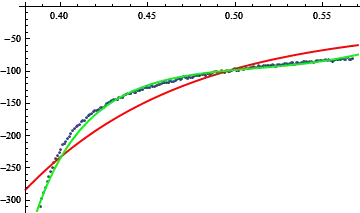What methods are there to fit a model of the form $y=A\mathrm e^{Bx}+C\mathrm e^{Dx}+E$?
Here is the actual scientific data to be fitted: http://dl.dropbox.com/u/39499990/Ben%2C%20real%20data.xlsx
B should be in the range of -1 to -100.
D should be in the range of -100 to -500.
E is a constant.
This specific model is of interest as it is an accepted one in the scientific community for describing the biological proccess in hand- Inactivation of a voltage dependent calcium channel. (for reference see for example: A novel molecular inactivation determinant of voltage-gated CaV1.2 L-type Ca2+ channel. A Livneh, R Cohen, and D Atlas; Neuroscience, Jan 2006; 139(4): 1275-87. " The rate of inactivation was analyzed by a biexponential decay -A1exp(-t/Tao1)-A2exp(-t/Tao2)+C " )
Best would be a solution that I could implement in Excel, by the use of build-in functions or VBA code.



